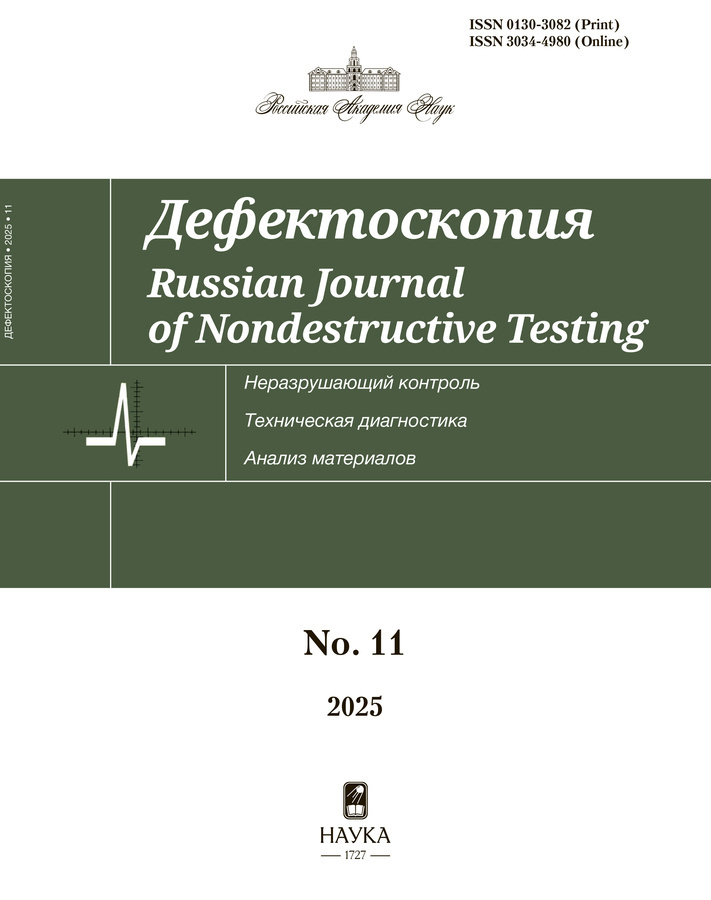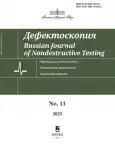No 11 (2025)
Acoustic methods
DISPERSION OF LAMB WAVES IN STEEL PLATES AFTER IRRADIATION WITH ACCELERATED ELECTRONS
Abstract
Operating conditions of fuel element cladding materials in nuclear reactors are characterized by intense radiation exposure capable of causing significant changes in their physical and mechanical properties. This work is devoted to the study of Lamb wave dispersion for materials used in fuel element cladding (FE) irradiated with 10 MeV fast electron beams. Complex measurements of the studied samples were carried out before and after irradiation. Irradiation-induced changes in practically important characteristics of steel plates were experimentally established. Based on the experimental data, refined dispersion dependences of Lamb waves were obtained, which made it possible to quantitatively estimate and analyze the degree of radiation modification of the acoustic and elastic characteristics of the material, as well as their correlation with the formation of radiation damage. It was found that Lamb waves excited in the zero symmetric mode are an effective source of information on the irradiation state of the material. The results of the conducted research are of certain interest for the development of the methodological base of ultrasonic non-destructive testing and in the field of physical materials science, related to increasing the reliability and durability of structural materials in extreme conditions. In particular, the obtained data can be used in the development of more accurate models for predicting the behavior of structural materials under conditions of intense radiation loads
 3-13
3-13


ASSESSMENT OF THE ACTUAL DIMENSIONS OF REFLECTORS BASED ON THEIR ACOUSTIC IMAGES
Abstract
The purpose of the article is to determine the possibility of assessing the geometric dimensions of various reflectors (drillings, grooves, flat bottomed holes) based on their acoustic images using the FMC&TFM method using the A1550 IntroVisor flaw detector as an example
 14-27
14-27


IMPROVING THE ACCURACY OF MEASURING THE PARAMETERS OF FREQUENCY-DEPENDENT ATTENUATION OF A LONGITUDINAL ULTRASONIC WAVE IN SOLIDS
Abstract
The article proposes a method for improving the accuracy of measuring the parameters of frequency-dependent attenuation of longitudinal ultrasonic waves in solids using standard flaw detectors and piezoelectric transducers (PEP). Traditional approaches such as Papadakis and Roth methods are considered and their limitations are revealed due to the difficulties of accounting for reflection coefficients, wave front divergence and the influence of the contact layer. An improved method based on the Rota method using a multi-frequency correction of the wavefront divergence is proposed, and an optimization method based on the NSGA-II genetic multicriteria algorithm for estimating attenuation parameters is proposed. The analysis of factors affecting the measurement accuracy is carried out, such as: frequency characteristics of the PEP, amplitude measurement errors, the presence of structural noise, sampling step, energy leakage at the boundaries of the sample, etc. The results of numerical experiments performed in the CIVA program, when using a converter with an operating frequency of 5 MHz, showed a relative error in measuring the speed of sound at ± 0,1%, attenuation coefficient ±1,5 %, and degree of frequency dependence ±20 %. A model experiment on a steel sample with two “steps” of 12 and 20 mm using a converter with an operating frequency of 10 MHz confirmed the practical applicability of the method: the relative error in measuring the longitudinal wave velocity for two “steps” can be estimated as ±0,1 %, the attenuation coefficient ±1 % and the degree of frequency dependence ±2 %. To increase accuracy, it is recommended to use PEP with an operating frequency of 10 MHz and the use of separately combined converters
 28-43
28-43


Comprehensive application of non-destructive testing methods
THREE-DIMENSIONAL MODELLING OF VISIBLE RADIATION PROPAGATION THROUGH CRYOGENIC TARGET WITH HARMONIC PERTURBATIONS OF SHELL AND SOLID FUEL LAYER
Abstract
An indirect-drive cryogenic target is a hollow spherical shell-capsule with solid layer of hydrogen isotopes (fuel) on its inner surface, located in a box-converter which in turn is mounted in a cryostat to provide for operation at a cryogenic temperature. Before placing a target in an ignition experiment at a megajoule energy level facility a thorough characterization of all component elements of the target and of the finished target must be completed. This paper describes three-dimensional modelling of a visible radiation beam propagation through a cryogenic target to study the robustness of optical shadow method for characterization of a solid fuel layer in an optically transparent shell in the presence of harmonic perturbations of various orders and amplitudes of the shell and fuel layer surfaces, as well as under non-ideal experimental conditions
 44-53
44-53


Radiation methods
DETERMINATION OF THE ELEMENTAL COMPOSITION OF METALS AND ALLOYS BY THE X-RAY FLUORESCENCE METHOD WITH INCREASED ACCURACY
Abstract
The work is devoted to the experimental substantiation of the need to take into account the dead time of the spectrometer when working with high input counting rate in the problems of analytical control of the elemental composition of metals and alloys. Using samples of steel, copper-nickel alloys, zirconium alloys, and zinc coatings on steel as an example, it is shown that taking into account the dead time of the spectrometer when working with high input counting rate in tasks of analytical control of the elemental composition of metals and alloys critically affects the accuracy of the measurement results. The error in determining the dead time contributes to the resulting value of the uncertainty of the intensities of the analytical lines. The principles of accounting for the dead time also apply to gamma-spectrometers, the use of which is also in demand in analytical control tasks
 54-69
54-69


Electromagnetic methods
ON SELECTION OF WORKING FREQUENCY OF MEDICAL METAL DAMAGE ELEMENT FINDER
Abstract
Ongoing armed conflicts necessitate the creation of new mo-diffusions of eddy current metal detectors to facilitate and accelerate surgical operations to attract damaging elements from patient bodies.Currently used specialized metal detectors have been developed in relation to the extraction of metal foreign bodies that are in the patient’s body for domestic or industrial reasons. These are pellets, sewing and injection needles (or their fragments), fragments of an in-tool, etc. The shape, size and electromagnetic properties of the damaging elements differ significantly from the corresponding properties of such foreign bodies. The proposed article discusses the features of the properties of damaging elements that must be taken into account when developing metal detectors that are currently oriented towards medical use. Results of numerical modeling of electromagnetic properties of damaging elements, which are of interest for substantiated selection of technical characteristics of specialized metal detectors, are given. It has been shown that it is useful to increase their operating frequencies to at least ten kilohertz and to use both phase components of the useful signal, summing their amplitudes by the absolute value
 70-81
70-81










